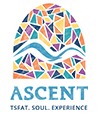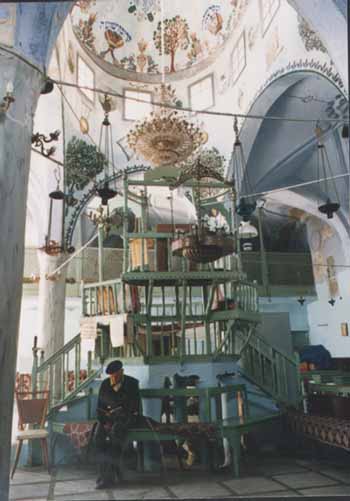The synagogue is named after Rabbi Yitzchak Abuhav, a renowned 15th century Spanish rabbi. Tradition claims he designed the synagogue while still in Spain, incorporating kabbalistic symbols into the design. When they arrived in Israel, his disciples built the synagogue according to their master’s design. Some say the synagogue was built in Spain, but after the expulsion it miraculously moved to Safed overnight.
The Courtyard.
Like the Holy Temple that once stood in Jerusalem, the synagogue entrance has an outer and an inner entrance separated by a courtyard. The interval between the inner and outer gates allows the worshipper to compose himself and enter the synagogue in an appropriate frame of mind.
Upon entering a synagogue, the Kabbalists would recite the formula: “I take upon myself the positive commandment to love my neighbor as myself.” (Levit. 19:18) They sought to come close to G-d not only through prayer but also by drawing closer to their fellows. After reciting the formula, they would act on their declaration by making donations to charity.
Three Arks.
Inside, three arks stand along the southern wall facing Jerusalem, This wall has withstood two earthquakes as well as various battles and assaults. It is the only part of the original building still standing. The ark on the right holds two Torah scrolls, one written by Rabbi Abuhav in Spain, the other written by a student of the Ari in the 16th century. This ark is opened only three times a year: on Yom Kippur, Shavuot, and Rosh HaShana. Although the Abuhav Torah is over 500 years old and infrequently used, the letters have remained legible.[it is perhaps the oldest Torah scroll in the world still in use —Y.T.]
The Torah scrolls in the middle ark are used regularly during the week. If you ask the sexton, he will open the ark for you. It is not clear why the third ark was built. There is an opinion that when the Turks ruled Israel they required Jews to keep a copy of the Koran in the synagogue; so perhaps this ark was built for that. Today it is used as a genizah (a place where worn-out holy books are stored until their burial).
The Dome.
The domed ceiling in the middle is decorated with drawings of musical instruments used by the Levite choir in the Temple in Jerusalem. The crowns depicted around the dome refer to the Mishnaic teaching [Avot 4:13] “There are three crowns: the crown of kingship, the crown of priesthood, and the crown of Torah. The crown of a good name surpasses all three.” The fifth crown, kerova yeshua, “Redemption is Near.” is not mentioned in the Talmud. It is a reprise of the dominant theme of 16th century Zefat: belief in the imminent arrival of the messianic age.
The painting of the Dome of the Rock, the mosque built on the site of King Solomon’s Temple, is visible from the synagogue’s entrance. According to tradition, the Temple was destroyed because of causeless hatred between Jews. Indeed, even while the Roman army was laying siege to Jerusalem, inside the city Jewish factions fought each other. Thus the Temple will be rebuilt when there is love and tolerance among Jews. The artist’s intent was to exhort Jews to tolerance and good will.
Elijah’s Chair.
Facing the center ark, it is used in the circumcision ceremony. The small chair attached to it is for the baby. The silver memorial plaque above the chair is for the six million Jews killed in the Holocaust.
The Bima.
The seats face the central bima (platform) where the Torah is read and, from where, following the Sephardic (Spanish) custom, the entire service is also recited. According to Kabbalah it has six steps, each representing a day of the week. This symbolizes man’s striving to raise his spiritual level each day, until he reaches the highest level — the Shabbat, or Torah.
Blue.
The predominant color of the synagogue is blue. The Torah commands Jews to put a blue thread in the tallit (prayer shawl). Rabbi Yosef Karo commented that blue suggests the heavens, which induces thought of G-d. The color thus helps direct thoughts and prayers to G-d.
Buy books about Safed and the ancient masters of Kabbalah at the Kabbala Online Shop.
abridged from: Safed: Six Self-Guided Tours, by Yisrael Shalem of blessed memory.
This book is available from Ascent, Box 296, Safed, Israel; email: ascent@AscentOfSafed.com

